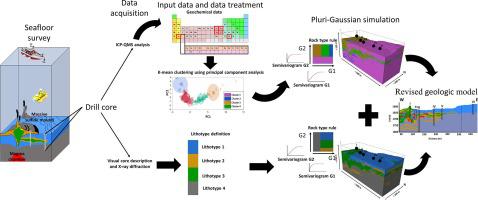Ore Geology Reviews ( IF 3.2 ) Pub Date : 2021-04-25 , DOI: 10.1016/j.oregeorev.2021.104194 Vitor Ribeiro de Sá , Katsuaki Koike , Tada-nori Goto , Tatsuo Nozaki , Yutaro Takaya , Toru Yamasaki

|
Seafloor hydrothermal deposits in the Okinawa Trough have been regarded as a modern analog of kuroko-type volcanogenic massive sulfide (VMS) deposits on land. VMS deposit is one of the primary producers of base metals (e.g. Cu, Pb, Zn) and precious metals (e.g. Au, Ag). However, owing to difficulties in accessing subseafloor samples/data without costly drilling operations, the spatial distribution of metal contents below the seafloor remains poorly constrained. We apply a combination of four spatial modeling methods: (1) principal component analysis; (2) k-means clustering; and (3, 4) conditional geostatistical simulations of turning bands and pluri-Gaussian. These modeling methods are based on the whole-rock geochemical data using inductively coupled plasma-quadruple mass spectrometry, together with lithologic log data obtained from onboard visual core descriptions, and X-ray diffraction analyses from the middle Okinawa Trough, Izena Hole, during the cruise CK16-05 (Expedition 909) in 2016 by D/V Chikyu. The primary goal is to construct plausible 3D models for the contents of base metals and silver as well as lithotypes. The constructed models successfully map the configuration and zonation of subseafloor metal deposits with hydrothermal flow paths, which sheds light on hydrothermal circulation systems and metal accumulation mechanisms. This approach is shown to be effective for geologic and mineralization modeling and exploration of (sub)seafloor hydrothermal deposits.
中文翻译:

3D地质统计模型的金属成分和岩相,用于确定伊泽那洞中部冲绳海槽中的海底热液矿床的矿化机理
冲绳海槽中的海底热液矿床已被视为陆地上kuroko型火山成因块状硫化物(VMS)矿床的现代类似物。VMS矿床是贱金属(例如Cu,Pb,Zn)和贵金属(例如Au,Ag)的主要生产商之一。然而,由于在不进行昂贵的钻井操作的情况下难以获取海底样品/数据,因此海底以下金属含量的空间分布仍然受到严格限制。我们将四种空间建模方法结合使用:(1)主成分分析;(2)k-均值聚类;(3,4)转向带和普里-高斯的条件地统计学模拟。这些建模方法基于全岩地球化学数据,采用电感耦合等离子体四重质谱法,D / V Chikyu。主要目标是为贱金属,银和光刻类型的内容构建合理的3D模型。所构建的模型成功绘制了具有热液流路径的海底金属矿床的构造和分区,这为热液循环系统和金属聚集机制提供了启示。事实证明,这种方法对于(亚)海底热液沉积物的地质和矿化建模和勘探是有效的。











































 京公网安备 11010802027423号
京公网安备 11010802027423号